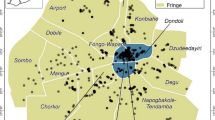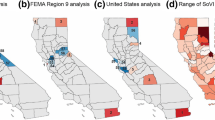Abstract
Infectious diseases continue to be a global health menace to society. Admittedly, there have been improvements in public health infrastructure and structural response to these diseases, however, a lot more needs to be done to have a firm grip. This study applied the geographically weighted poisson regression (GWPR) model to study the spatial variations in the effects of socioeconomic factors on COVID-19 Mortality in the African subregion. The performance of the GWPR model was compared to the conventional Poisson regression model. The results suggest that accounting for the spatial heterogeneity through the GWPR model (RMSE = 100.604, MAE = 70.582, Pseudo R2 = 0.773) improves the modelling performance compared to the conventional Poisson regression model (RMSE = 118.574, MAE = 83.054, Pseudo R2 = 0.530). In addition, the effects of all the socioeconomic variables considered (i.e., educational index, unemployment rates, income index, gross domestic product, and forest area) on COVID-19 mortality were found to be spatial non-stational across the subregion. These results highlight the need to draw preventive and response policies applicable to infectious diseases with greater consideration of the different geographical points on the continent.





Similar content being viewed by others
Data availability
The dataset used and/or analysed during the current study is available in the public domain.
References
Altig D, Baker S, Barrero JM, Bloom N, Bunn P, Chen S, Mihaylov E (2020) Economic uncertainty before and during the COVID-19 pandemic. J Public Econ 191:104274
Anyanwu JC, Salami AO (2021) The impact of COVID-19 on African economies: an introduction. Afr Dev Rev 33(Suppl 1):S1
Barrichello A, Morano RS, Jacomossi RR, Feldmann PR (2022) THE ROLE OF EDUCATION ON INFECTIOUS DISEASES MORTALITY RATES: THE COVID-19 CASE. South Am Dev Soc J 8(22):117
Brenner MH (2021) Unemployment, bankruptcies, and deaths from multiple causes in the COVID-19 recession compared with the 2000–2018 great recession impact. Am J Public Health 111(11):1950–1959
Brunsdon C, Fotheringham AS, Charlton M (2002) Geographically weighted summary statistics — a framework for localised exploratory data analysis. Comput Environ Urban Syst 26(6):501–524. https://doi.org/10.1016/S0198-9715(01)00009-6
Center for Disease Control and Prevention (2022) Covid-19. Retrieved from https://www.cdc.gov/coronavirus/2019-ncov/your-health/index.html
Chang D, Chang X, He Y, Tan KJK (2022) The determinants of COVID-19 morbidity and mortality across countries. Sci Rep 12(1):5888
Ciotti M, Ciccozzi M, Terrinoni A, Jiang W-C, Wang C-B, Bernardini S (2020) The COVID-19 pandemic. Crit Rev Clin Lab Sci 57(6):365–388
Coleman M, Rachet B, Woods L, Mitry E, Riga M, Cooper N, Estève J (2004) Trends and socioeconomic inequalities in cancer survival in England and Wales up to 2001. Br J Cancer 90(7):1367–1373
Fotheringham AS, Brunsdon C, Charlton M (2003) Geographically weighted regression: the analysis of spatially varying relationships. Wiley
Goodman NP, Coyne CJ, Devereaux A (2021) Infectious diseases and Government Growth. Indep Rev 25(4):537–550
Green PJ (1984) Iteratively reweighted least squares for maximum likelihood estimation, and some robust and resistant alternatives. J Roy Stat Soc: Ser B (Methodol) 46(2):149–170
Guégan J-F, Ayouba A, Cappelle J, De Thoisy B (2020) Forests and emerging infectious diseases: unleashing the beast within. Environ Res Lett 15(8):083007
Hilbe JM (2014) Modeling count data. Cambridge University Press, UK
Huremović D (2019) Brief history of pandemics (pandemics throughout history). Psychiatry of Pandemics. Springer, pp 7–35
Kanu IA (2020) COVID-19 and the economy: an African perspective. J Afr Stud Sustainable Dev 3(2):29–36
Karjalainen E, Sarjala T, Raitio H (2010) Promoting human health through forests: overview and major challenges. Environ Health Prev Med 15(1):1–8
Lazar M, Davenport L (2018) Barriers to health care access for low income families: a review of literature. J Commun Health Nurs 35(1):28–37
Lone SA, Ahmad A (2020) COVID-19 pandemic–an African perspective. Emerg Microbes Infections 9(1):1300–1308
Mackenbach JP, Stirbu I, Roskam A-JR, Schaap MM, Menvielle G, Leinsalu M, Kunst AE (2008) Socioeconomic inequalities in health in 22 European countries. N Engl J Med 358(23):2468–2481
Marí-Dell’Olmo M, Gotsens M, Pasarín MI, Rodríguez-Sanz M, Artazcoz L, de Garcia P, Borrell C (2021) Socioeconomic inequalities in COVID-19 in a European urban area: two waves, two patterns. Int J Environ Res Public Health 18(3):1256
McCullagh P, Nelder JA (1989) Generalized linear models. Routledge, New York
Mirahmadizadeh A, Shamooshaki MTB, Dadvar A, Moradian MJ, Aryaie M (2022) Unemployment and COVID-19-related mortality: a historical cohort study of 50,000 COVID-19 patients in Fars, Iran. Epidemiol Health 44:e2022032
Murakami D, Tsutsumida N, Yoshida T, Nakaya T, Lu B, Harris P (2023) A linearization for stable and fast geographically weighted Poisson regression. Int J Geogr Inf Sci, 1–22
Nakaya T, Fotheringham AS, Brunsdon C, Charlton M (2005) Geographically weighted Poisson regression for disease association mapping. Stat Med 24(17):2695–2717
Oshakbayev K, Zhankalova Z, Gazaliyeva M, Mustafin K, Bedelbayeva G, Dukenbayeva B, Tordai A (2022) Association between COVID-19 morbidity, mortality, and gross domestic product, overweight/obesity, non-communicable diseases, vaccination rate: a cross-sectional study. J Infect Public Health 15(2):255–260
Roviello V, Roviello GN (2021) Lower COVID-19 mortality in Italian forested areas suggests immunoprotection by Mediterranean plants. Environ Chem Lett 19(1):699–710
Samal J (2014) A historical exploration of pandemics of some selected diseases in the world. Int J Health Sci Res 4(2):165–169
Singh GK, Siahpush M (2006) Widening socioeconomic inequalities in US life expectancy, 1980–2000. Int J Epidemiol 35(4):969–979
Skórka P, Grzywacz B, Moroń D, Lenda M (2020) The macroecology of the COVID-19 pandemic in the Anthropocene. PLoS ONE, 15(7), e0236856
Smith KF, Goldberg M, Rosenthal S, Carlson L, Chen J, Chen C, Ramachandran S (2014) Global rise in human infectious disease outbreaks. J Royal Soc Interface 11(101):20140950
Steele J, Shen J, Tsakos G, Fuller E, Morris S, Watt R, Wildman J (2015) The interplay between socioeconomic inequalities and clinical oral health. J Dent Res 94(1):19–26
UNDESA (2020) World Population Prospects. Retrieved from https://population.un.org/wpp/
Usman M, Ali Y, Riaz A, Riaz A, Zubair A (2020) Economic perspective of coronavirus (COVID-19). J Public Affairs, 20(4), e2252
Wadvalla B-A (2020) How Africa has tackled covid-19. bmj, 370
Wang S, Shi C, Fang C, Feng K (2019) Examining the spatial variations of determinants of energy-related CO2 emissions in China at the city level using geographically weighted regression model. Appl Energy 235:95–105
WHO (2022a) Health Topics. World Health Organization. Retrieved from https://www.who.int/health-topics
WHO (2022b) WHO Coronavirus (COVID-19) Dashboard. Retrieved from https://covid19.who.int/
Wilkinson TJ, Lightfoot CJ, Smith AC, Yates T, Khunti K, Zaccardi F (2022) Association of Ethnicity and Socioeconomic Status with COVID-19 hospitalization and mortality in those with and without chronic kidney disease. Kidney Int Rep 7(2):334
World Bank (2020) World Development Indicators database. Retrieved from https://databank.worldbank.org/source/world-development-indicators
Xu H, Croot P, Zhang C (2022) Exploration of the spatially varying relationships between lead and aluminium concentrations in the topsoil of northern half of Ireland using geographically weighted Pearson correlation coefficient. Geoderma 409:115640
Yu H, Peng Z-R (2019) Exploring the spatial variation of ridesourcing demand and its relationship to built environment and socioeconomic factors with the geographically weighted Poisson regression. J Transp Geogr 75:147–163
Funding
This research did not receive any specific grant from funding agencies in the public, commercial, or not-for-profit sectors.
Author information
Authors and Affiliations
Contributions
Yaw Kwaafo Awuah-Mensah prepared and wrote the main manuscript text. All authors collected, cleaned and analysed the data used for the manuscript. Eric Nimako Aidoo read and approved the final manuscript. All authors saw to the preparation of a revised version as commented by the reviewers.
Corresponding author
Ethics declarations
Conflict of interest
The authors have no conflict of interest to declare that are relevant to the content of this article.
Additional information
Communicated by Hassan Babaie.
Publisher’s Note
Springer Nature remains neutral with regard to jurisdictional claims in published maps and institutional affiliations.
Rights and permissions
Springer Nature or its licensor (e.g. a society or other partner) holds exclusive rights to this article under a publishing agreement with the author(s) or other rightsholder(s); author self-archiving of the accepted manuscript version of this article is solely governed by the terms of such publishing agreement and applicable law.
About this article
Cite this article
Awuah-Mensah, Y.K., Aidoo, E.N. Modelling the spatial varying relationships between socioeconomic inequalities and COVID-19 mortality in the African subregion. Earth Sci Inform (2024). https://doi.org/10.1007/s12145-024-01321-7
Received:
Accepted:
Published:
DOI: https://doi.org/10.1007/s12145-024-01321-7




